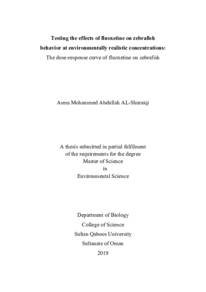وثيقة
Testing the effects of fluoxetine on zebrafish behavior at environmentally realistic concentrations : the dose-response curve of fluoxetine on zebrafish.
المعرف
Al-Shuraiqiyah, Asma Mohammed Abdullah (2019). Testing the effects of fluoxetine on zebrafish behavior at environmentally realistic concentrations : the dose-response curve of fluoxetine on zebrafish (Master thesis, Sultan Qaboos University, Muscat, Oman)
الناشر
Sultan Qaboos University.
ميلادي
2019
اللغة
الأنجليزية
الملخص الإنجليزي
Pharmaceuticals are an emerging source of pollution and can now be detected
in surface waters around the world. Antidepressants are one of the most commonly
detected classes. Fluoxetine (Prozac) is the most widely prescribed antidepressant and
acts as selective serotonin reuptake inhibitor that increases the concentration of
serotonin in the brain. Fluoxetine alters behavior in many non-target species including
fish, amphibians, and invertebrates. However, the nature of the dose-response
relationship for fluoxetine remains controversial and debate remains as to whether it
is monotonic or non-monotonic. The aim of this study was to measure the effects of
fluoxetine on the swimming behavior and response to predators of zebrafish (Danio
rerio) and determine the shape of the response curve.
Adult zebrafish were exposed to eight different concentrations of the
antidepressant drug fluoxetine: 0, 5, 10, 50, 100, 500, 1000, or 5000 ng/L for four
weeks. The swimming behavior and response to alarm pheromone were measured on
days 7, 14, and 28 of exposure for groups and individual fish. Seven days after the end
of the exposure, fish were allowed to breed and unexposed F1 larvae were collected.
The larval response to light was measured on days 7, 9, 11, 21, and 28 while the
response to conspecific alarm chemical was measured on day 28. After breeding, 50%
of the fish were euthanized and frozen in liquid nitrogen, while the remaining 50% of
the adult fish were exposed to alarm chemical for ten minutes then euthanized.
Subsequently, the cortisol concentration in all fish was measured.
On day 7 fish exposed to concentrations of fluoxetine >100 ng/L significantly
decreased swimming speed relative to controls, while after addition of the alarm cue
all treatments except controls decreased swimming speed. On day14 there was no
effect of fluoxetine on swimming before the alarm, but after addition, all groups except
the control decreased swimming. On day 28 the pattern before the addition of alarm
was similar to day 14 and afterward all groups except the control and 500 ng/L fish
decreased swimming speed. Fishes also showed changes in other behavioral responses
including angular acceleration, nearest neighbor distance, and distance to the wall. The
viii
unexposed larvae of fish exposed to 500 ng/L showed a decrease in swimming
compared with other groups.
In conclusion, my results suggest that there is a critical response window
around a concentration of 500 ng/L where fish are most sensitive to fluoxetine. I also
observed that responses are time-dependent and fish show some adaptation to the
chemical in terms of swimming but not in response to predator alarm. As avoidance
of predators is a vital behavior for fish, the effects of fluoxetine on this response could
cause a negative impact on natural populations. This study highlights the complex
effects that pharmaceuticals can have on non-target species in the natural environment
and the need for better treatment of effluents before discharge into surface waters.
المجموعة
URL المصدر
قالب العنصر
الرسائل والأطروحات الجامعية

